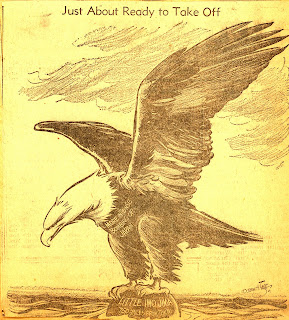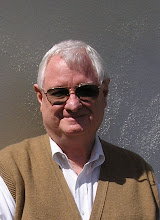 Scrapbook Clipping 1845 - Mexico, Missouri - Archives of The Museum of the San Fernando Valley - 2009 (click on image to enlarge)
Scrapbook Clipping 1845 - Mexico, Missouri - Archives of The Museum of the San Fernando Valley - 2009 (click on image to enlarge)The following is a handwritten account by our kinsman the late James L. Fecht.
"One of the guys in our outfit was killed by rifle fire and we buried him in a shallow grave and stuck his rifle with a bayonet on it in the ground with his helmet and dog-tags on to mark the grave sit as we moved on up thru the lines. After the fight was over two of us wee sent back to bring his body back to a grave registration outfit. On the way back I was walking ahead and tripped a booby trap wire that was hooked to a grenade in a small scrub tree just at the height of my head. My buddy hit the deck behind me but I sensed it was too late for me, so I just stood there cursing my luck with the grenade went off and I realized it was just a Jap phosphorous grenade that was used to light up the area at night to see anyone passing that way. I was a nervous wreck for several days after that.
A Jap artillery shell hit a bluff about 10 yards form my buddy and me as we were dug in a fox hole below. When it went off it covered us with dirt and dust. a pill box 200 yards ahead of us knew we were there and kept us pinned down with a lite Nambu machine gun until a tank moved us and silenced them.
We could not sleep for the first few nites but then exhaustion crept in and we could take times sleeping while one kept watch, the other slept, even with the shells bursting all around.
Our secret to advancement was overpowering fire power. Continuous bombardment with all we had. Once we moved past the first airfield, we were able to bring in rocket launchers, artillery and tanks to help us progress. The well fortified pill boxes of reinforced concrete covered with dirt were our biggest problem. They were so placed that they covered each other's flanks. As a tank would move in toward me it would be knocked out by an unseen pill box from its flank firing 47 m.m. anti-tank high explosive shells. We had to take extra caution while going in with a tank as these shells burst all around us.
One pill box had us pinne down with machine gun fire so we couldn't cross an open spot to get to it, and one our guys an Indian boy from Montana by the name of Mix crawled almost 100 yards under the fire and lobbed a grenade thru the port hole slit in the pill box, killing all inside and letting advance another 100 yards. I think he got the silver star for that action but I never heard for sure.
Almost two thirds of the way up the Island we were paired off in twos in our sandy fox holes and a one guy kept watch the other could sleep. Our sleep was forever getting interrupted by someone slipping along crawling toward our supplies of food and water, and by the eerie light of our flares -shooting was sporadic all night. Toward the end though we would be rushed by groups of 10, 20 and 100 trying to break out resulting in viscous fire fights.
One day my buddy from New York, Homer Davis and I got pinned down and couldn't get out of our fox hole. The Japs were firing all the mortars and rockets they had left and were keeping us pinned down. All we had to eat was canned cheese. We ate cheese for two days.
We had a wicked fire fight one night about 2 AM. About 400 Japs charge thru a thicket of small trees just ahead of us right at our front line. The brunt of the chare hit the 4th Marines on our right and almost a 100 headed into us. We fired at every shadow from the flares overhead for about 2 hours and then it tapered off to just an occasional burst of fire here and there. Next daylight we scouted on up three trees and saw dead bodies stacked up like cord wood in front of us. The closest in front of me had a beautiful cow hide pack and a Jap flag inside his helmet. I still have his pack but lost the flag after all these years.
We followed the flame-throwers on up the Island as they fired into the hundreds of caves, and we fired as they scrambled out of their holes like ants.
When we reached the farthest point of the Island all organized resistance was over and it was just mopping up and blowing up the caves and pill boxes. Our company captain gave me a dispatch case with information on all the guys in our outfit that had been killed or wounded and was told to catch the first boat going back to Guam and deliver the information to our Regimental Headquarters back there.
I caught a LCVI (Landing Craft Vehicle Infarty?) and we sailed back to Guam. I caught a ride with a truck headed over to the other side of the island where our rear echelon was still in camp. The truck let me off at the front of a palm grove and I started walking back up to our tent city. When the group that were left behind in our rear echelon saw me coming up the road alone a cry went up and the guys came running down the road to meet me saying, "Where is the rest of the outfit?" "Are you the only one left Fecht?" "We've been listening to the battle on the radio, did everyone else get killed?" It took me a few minutes to quiet them down and reassure them that most of our buddies made it ok.
The Battle of Iwo Jima gave me enough combat points to gain a furlough back in the Sates and home for awhile. I spent the next three weeks saying goodbye to all my buddies and the native families that I had met there on Guam."






